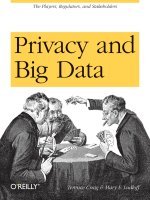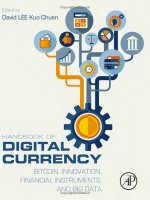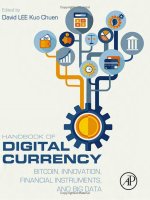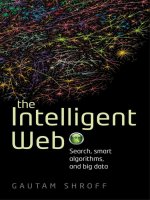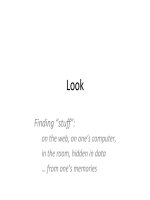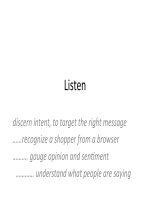courser web intelligence and big data 5 learn lecture slides
Bạn đang xem bản rút gọn của tài liệu. Xem và tải ngay bản đầy đủ của tài liệu tại đây (541.59 KB, 16 trang )
Learn
learning
re-‐visited
….
unsupervised
learning
–
‘business’
rules
………
features
and
classes
together
(recommenda=ons)
……………..learning
‘facts’
from
collec=ons
of
text
(web)
……………………what
is
‘knowledge’?
learning
re-‐visited:
classifica=on
data
has
(i)
features
x1
…
xN
=
X
(e.g.
query
terms,
words
in
a
comment)
and
(ii)
output
variable(s)
Y,
e.g.
class
y,
classes
y1
…
yk
(e.g.
buyer/browser,
posi=ve/nega=ve:
y=0/1,
in
general
need
not
be
binary)
classifica'on:
suppose
we
define
a
func=on:
f(X)
=
E[Y|X]
i.e.,
expected
value
of
Y
given
X
e.g.
if
Y
=
y,
and
y
is
0/1;
then
f(X)
=
1*P(y=1|X)
+
0*P(y=0|X)
=
P(y=1|X)
–
which
we
earlier
es=mated
using
Naïve
Bayes
+
a
training
set
examples:
old
and
new
queries
comments
R F G C Buy?
Words
animals
Sen'ment
size
head
noise
legs
animal
L
L
roar
4
lion
S
S
meow
4
cat
n n y y
y
like,
lot
posi=ve
y n n y
y
hate,
waste
nega=ve
y y y n
n
enjoying,
lot
posi=ve
XL
trumpet
4
elephant
y
nega=ve
XL
y y y n
enjoy,
lot,
[not]
[not],
enjoy
nega=ve
M
M
bark
4
dog
y y y n
n
S
S
chirp
2
bird
y y y y
n
M
S
bark
4
dog
M
M
speak
2
human
M
S
squeal
2
bird
L
M
roar
4
=ger
(Y,
X)
=
(S,
all
words)
binary
variables
…..
Items
Bought
……
milk,
diapers,
cola
(Y,
X)
=
(B,
R,
F,
G,
C)
binary
variables
diapers,
beer
milk,
cereal,
beer
soup,
pasta,
sauce
transac=ons:
beer,
nuts,
diapers
(Y,
X)
=
(A,
S,
H,
N,
L)
fixed
set
of
mul=-‐valued,
categorical
variables
(Y,
X)
=
(
_
,
items)
variable
set
of
mul=-‐valued
categorical
variables
how
do
classes
emerge?
clustering
groups
of
‘similar’
users/user-‐queries
based
on
terms
groups
of
similar
comments
based
on
words
groups
of
animal
observa=ons
having
similar
features
clustering
find
regions
that
are
more
populated
than
random
data
P(X)
r
=
i.e.
regions
where
is
large
(here
P0(X)
is
uniform)
P0 (X)
set
y
=
1
for
all
data;
then
add
data
uniformly
with
y
=
0
r
then
f(X)
=
E[y|X]
=
1+
r
;
now
find
regions
where
this
is
large
how
to
cluster?
k-‐means,
agglomera=ve,
even
LSH
!
….
rule
mining:
clustering
features
like
&
lot
=>
posi=ve;
not
&
like
=>
nega=ve
searching
for
flowers
=>
searching
for
a
cheap
gih
bird
=>
chirp
or
squeal;
chirp
&
2
legs
=>
bird
diapers
&
milk
=>
beer
sta's'cal
rules
find
regions
more
populated
than
if
xi’s
were
independent
so
this
=me
P0(X)
=
∏
P(x
i
)
,
i.e.,
assuming
feature
independence
i
again,
set
y
=
1
for
all
real
data
add
y
=
0
points,
choosing
each
xk
uniformly
from
the
data
itself
r
1+ r
P(X)
P0 (X)
f(X)
=
E[y|X]
again
es=mates
;r
=
;
its
extreme
regions
are
those
of
with
support
and
poten=al
rules
associa=on
rule
mining
infer
rule
A,
B,
C
=>
D
if
(i) high
support:
P(A,B,C,D)
>
s
(ii) high
confidence:
P(D|A,B,C)
>
c
(iii) high
interes9ngness:
P(D
|
A,
B,
C)
>
i
P(D)
how?
key
observa=on:
if
A,B
has
support
>
s
then
so
does
A:
•
•
•
•
scan
all
records
for
support
>
s
values
scan
this
subset
for
all
support
>
s
pairs
…
triples,
etc.
un=l
no
sets
with
support
>
s
then
check
each
set
for
confidence
and
interes=ngness
Note:
just
coun=ng,
so
map-‐reduce
is
ideal
Items
Bought
milk,
diapers,
cola
diapers,
beer
milk,
cereal,
beer
soup,
pasta,
sauce
beer,
nuts,
diapers
problems
with
associa=on
rules
characteriza'on
of
classes
• small
classes
get
leh
out
Ø
use
decision-‐trees
instead
of
associa=on
rules
based
on
mutual
informa=on
-‐
costly
learning
rules
from
data
• high
support
means
nega=ve
rules
are
lost:
e.g.
milk
and
not
diapers
=>
not
beer
Ø use
‘interes=ng
subgroup
discovery’
instead
“Beyond
market
baskets:
generalizing
associa=on
rules
to
correla=ons”
ACM
SIGMOD
1997
Sergey
Brin,
Rajeev
Motwani,
and
Craig
Silverstein
unified
framework
and
big
data
we
defined
f(X)
=
E[Y|X]
for
appropriate
data
sets
yi=0/1
for
classifica=on;
problem
A:
becomes
es=ma=ng
f
added
random
data
for
clustering
added
independent
data
for
rule
mining
-‐ problem
B:
becomes
finding
regions
where
f
is
large
now
suppose
we
have
‘really
big’
data
(long,
not
wide)
i.e.,
lots
and
lots
of
examples,
but
limited
number
of
features
problem
A
reduces
to
querying
the
data
problem
B
reduces
to
finding
high
support
regions
just
coun=ng
…
map-‐reduce
(or
Dremel)
work
by
brute
force
…
[wide
data
is
s=ll
a
problem
though]
dealing
with
the
long-‐tail
no
par=cular
book-‐set
has
high
support;
in
fact
s
≈
0!
“customers
who
bought
…”
how
are
customers
compared?
people
documents
experiences
-‐
‘see
animal’
observa=ons
class
es
a
nd
f
eme eatur
es
rge?
people
have
varied
interests
books
words
features
-‐
legs,
noise
percep=ons
collabora've
filtering
latent
seman'c
models
“hidden
structure”
one
approach
to
latent
models:
NNMF
Y:
k
x
n
m
words
people
people
A:
m
x
n
≈
n
books
books
documents
X:
m
x
k
k
roles
n
genres
k
topics
matrix
A
needs
to
be
wriren
as
A
≈
X
Y
since
X
and
Y
are
‘smaller’,
this
is
a
almost
always
an
approxima=on
so
we
minimize
||
A
−
XY
||
F
(here
F
means
sum
of
squares)
subject
to
all
entries
being
non-‐nega9ve
–
hence
NNMF
other
methods
–
LDA
(latent
dirichlet
alloca=on),
SVD,
etc.
back
to
our
hidden
agenda
classes
can
be
learned
from
experience
features
can
be
learned
from
experience
e.g.
genres,
i.e.,
classes
as
well
as
roles,
i.e.,
features
merely
from
“experiences”
what
is
the
minimum
capability
needed?
1. lowest
level
of
percep=on:
pixels,
frequencies
2. subi=zing
i.e.,
coun=ng
or
dis=nguising
between
one
and
two
things
being
able
to
break
up
temporal
experience
into
episodes
theore=cally,
this
works;
in
prac=ce
….
lots
of
research
…
beyond
independent
features
buy/browse
B:
y
/
n
cheap
sen=ment
gih
flower
Si:
+
/
-‐
Si+1:
+
/
-‐
don’t
like
i
i+1
if
‘cheap’
and
‘gih’
are
not
independent,
P(G|C,B)
≠
P(G|B)
(or
use
P(C|G,B),
depending
on
the
order
in
which
we
expand
P(G,C,B)
)
“I
don’t
like
the
course”
and
“I
like
the
course;
don’t
complain!”
first,
we
might
include
“don’t”
in
our
list
of
features
(also
“not”
…)
s=ll
–
might
not
be
able
to
disambiguate:
need
posi9onal
order
P(xi+1|xi,
S)
for
each
posi=on
i:
hidden
markov
model
(HMM)
we
may
also
need
to
accomodate
‘holes’,
e.g.
P(xi+k|xi,
S)
learning
‘facts’
from
text
Si-‐1:
subject
Vi:
verb
Oi+1:
object
an=bio=cs
person
kill
gains
weight
bacteria
i-‐1
i
i+1
suppose
we
want
to
learn
facts
of
the
form
object>
from
text
single
class
variable
is
not
enough;
(i.e.
we
have
many
yj
in
data
[Y,X])
further,
posi=onal
order
is
important,
so
we
can
use
a
(different)
HMM
..
e.g.
we
need
to
know
P(xi|xi-‐1,Si-‐1,
Vi)
whether
‘kills’
following
‘an=bio=cs’
is
a
verb
will
depend
on
whether
‘bacteria’
is
a
subject
more
apparent
for
the
case
weight>,
since
‘gains’
can
be
a
verb
or
a
noun
problem
reduces
to
es=ma=ng
all
the
a-‐posterior
probabili=es
P(Si-‐1,Vi,
Oi+1)
for
every
i
,
and
also
allowing
‘holes’
(i.e.,
P(Si-‐k,Vi,
Oi+p)
)
and
find
the
best
facts
from
a
collec=on
of
text?
….
many
solu=ons;
apart
from
HMMs
-‐
CRFs
aher
finding
all
facts
from
lots
of
text,
we
cull
using
support,
confidence,
etc.
open
informa=on
extrac=on
Cyc
(older,
semi-‐automated):
2
billion
facts
Yago
–
largest
to
date:
6
billion
facts,
linked
i.e.,
a
graph
e.g.
wasBornIn,
Ulm>
Watson
–
uses
facts
culled
from
the
web
internally
REVERB
–
recent,
lightweight:
15
million
S,V,O
triples
e.g.
also
rich
in,
vitamin
C>
1. part-‐of-‐speech
tagging
using
NLP
classifiers
(trained
on
labeled
corpora)
2. focus
on
verb-‐phrases;
iden=fy
nearby
noun-‐phrases
3. prefer
proper
nouns,
especially
if
they
occur
ohen
in
other
facts
4. extract
more
than
one
fact
if
possible:
“Mozart
was
born
in
Salzburg,
but
moved
to
Vienna
in
1781”
yields
to,
Vienna>,
in
addi=on
to
born
in,
Salzburg>
to
what
extent
have
we
‘learned’?
Searle’s
Chinese
room:
rules
Chinese
facts
English
‘mechanical’
reasoning
does
the
translator
‘know’
Chinese?
much
of
machine
transla=on
uses
similar
techniques,
as
well
as
HMMs,
CRFs,
etc.
to
parse
and
translate
recap
and
preview
learning,
or
‘extrac=ng’:
classes
from
data
–
unsupervised
(clustering)
rules
from
data
-‐
unsupervised
(rule
mining)
big
data
–
coun=ng
works
(unified
f(X)
formula=on)
classes
&
features
from
data
–
unsupervised
(latent
models)
next
week
facts
from
text
collec=ons
–
supervised
(Bayesian
n/w,
HMM)
can
also
be
unsupervised:
use
heuris=cs
to
bootstrap
training
sets
what
use
are
these
rules
and
facts?
reasoning
using
rules
and
facts
to
‘connect
the
dots’
logical,
as
well
as
probabilis=c,
i.e.,
reasoning
under
uncertainty
seman=c
web


